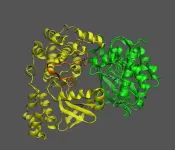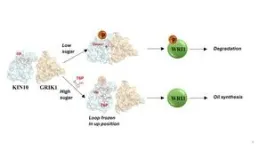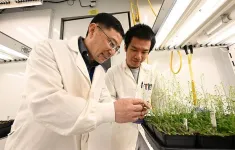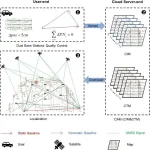(Press-News.org) UPTON, N.Y. — Proteins are molecular machines, with flexible pieces and moving parts. Understanding how these parts move helps scientists unravel the function a protein plays in living things — and potentially how to change its effects. Biochemists at the U.S. Department of Energy’s (DOE) Brookhaven National Laboratory and colleagues at DOE’s Pacific Northwest National Laboratory (PNNL) have just published a new example of how one such molecular machine works.
Their paper in the journal Science Advances describes how the moving parts of a particular plant protein control whether plants can grow and make energy-intensive products such as oil — or instead put in place a series of steps to conserve precious resources. The study focuses specifically on how the molecular machinery is regulated by a molecule that rises and falls with the level of sugar — plants’ main energy source.
“This paper reveals the detailed mechanism that tells plant cells, ‘we have lots of sugar,’ and then how that signaling affects the biochemical pathways that trigger processes like plant growth and oil production,” said Brookhaven Lab biochemist Jantana Blanford, the study’s lead author.
The study builds on earlier work by the Brookhaven team that uncovered molecular links between sugar levels and oil production in plants. One potential goal of this research is to identify specific proteins — and parts of proteins — scientists can engineer to make plants that produce more oil for use as biofuels or other oil-based products.
“Identifying exactly how these molecules and proteins interact, as this new study does, brings us closer to identifying how we might engineer these proteins to increase plant oil production,” said John Shanklin, chair of Brookhaven Lab’s Biology Department and leader of the research team.
Unraveling molecular interactions
The team used a combination of laboratory experiments and computational modeling to zero in on how the molecule that serves as a sugar proxy binds to a “sensor kinase” known as KIN10. KIN10 is the protein that contains the moving parts that determine which biochemical pathways are on or off.
The scientists already knew that KIN10 acts as both a sugar sensor and a switch: When sugar levels are low, KIN10 interacts with another protein to set off a cascade of reactions that ultimately shut down oil production and break down energy-rich molecules like oil and starch to make energy that powers the cell. But when sugar levels are high, KIN10’s shut-down function is shut off — meaning plants can grow and make lots of oil and other products with the abundant energy.
But how does the sugar proxy binding to KIN10 flip the switch?
To find out, Blanford started with the adage of “opposites attract.” She identified three positively charged parts of KIN10 that might be attracted to abundant negative charges on the the sugar proxy molecule. A laboratory-based process of elimination that involved making variations of KIN10 with modifications to these sites identified the one true binding site.
Then the Brookhaven team turned to computational colleagues at PNNL.
Marcel Baer and Simone Raugei at PNNL examined at the atomic level how the sugar proxy and KIN10 fit together.
“By using multiscale modeling we observed that the protein can exist in multiple conformations but only one of them can effectively bind the sugar proxy,” Baer said.
The PNNL simulations identified key amino acids within the protein that control the binding of the sugar. These computational insights were then confirmed experimentally.
The combined body of experimental and computational information helped the scientists understand how interaction with the sugar proxy directly affects the downstream action of KIN10.
Flipping the switch
“Additional analyses showed that the entire KIN10 molecule is rigid except for one long flexible loop,” Shanklin said. The models also showed that the loop’s flexibility is what allows KIN10 to interact with an activator protein to trigger the cascade of reactions that ultimately shut down oil production and plant growth.
When sugar levels are low, and little sugar proxy molecule is present, the loop remains flexible, and the shutdown mechanism can operate to reduce plant growth and oil production. That makes sense to conserve precious resources, Shanklin said.
But when sugar levels are high, the sugar proxy binds tightly to KIN10.
“The calculations show how this small molecule blocks the loop from swinging around and prevents it from triggering the shutdown cascade,” Blanford said.
Again, this makes sense since abundant sugar is available for plants to make oil.
Now that the scientists have this detailed information, how might they put it to use?
“We could potentially use our new knowledge to design KIN10 with altered binding strength for the sugar proxy to change the set point at which plants make things like oil and break things down,” Shanklin said.
This work was supported by the DOE Office of Science (BES). Computer time was provided by the National Energy Research Scientific Computing Center (NERSC) at Lawrence Berkeley National Laboratory and the Molecular Sciences Computing Facility (MSCF) in the Environmental Molecular Sciences Laboratory at Pacific Northwest National Laboratory. NERSC and MSCF are DOE Office of Science user facilities.
Brookhaven National Laboratory is supported by the Office of Science of the U.S. Department of Energy. The Office of Science is the single largest supporter of basic research in the physical sciences in the United States and is working to address some of the most pressing challenges of our time. For more information, visit science.energy.gov.
Follow @BrookhavenLab on social media. Find us on Instagram, LinkedIn, X, and Facebook.
Related Links
Scientific paper: "Molecular mechanism of trehalose 6-phosphate inhibition of the plant metabolic sensor kinase SnRK1"
Study IDs Link Between Sugar Signaling and Regulation of Oil Production in Plants
With Extra Sugar, Leaves Get Fat Too
How a Molecular Signal Helps Plant Cells Decide When to Make Oil END
Scientists discover mechanism of sugar signaling in plants
Findings reveal how a sugar-sensing protein acts as a "machine" to switch plant growth — and oil production — on and off
2024-05-17
ELSE PRESS RELEASES FROM THIS DATE:
Cleveland Clinic research finds VISTA directly blocks T-cells from functioning in immunotherapy
2024-05-17
A Cleveland Clinic-led team of scientists and physicians have discovered that the immune checkpoint protein VISTA can directly turn off tumor-fighting T-cells during immunotherapy and resist treatment.
The study, published in Science Immunology, explains that VISTA can bind to a protein called LRIG1 in T cells, which was previously only thought to promote bone and fat development. When VISTA binds to LRIG1, the researchers found, LRIG1 sends signals that suppress T cell replication, survival ...
Pagan-Christian trade networks supplied horses from overseas for the last horse sacrifices in Europe
2024-05-17
Horses crossed the Baltic Sea in ships during the Late Viking Age and were sacrificed for funeral rituals, according to research from Cardiff University.
Published in the journal Science Advances, studies on the remains of horses found at ancient burial sites in Russia and Lithuania show that they were brought overseas from Scandinavia utilising expansive trade networks connecting the Viking world with the Byzantine and Arab Empires.
Up to now, researchers had believed sacrificial horses were always locally-sourced stallions. ...
University of Bristol researchers develop world’s smallest quantum light detector on a silicon chip
2024-05-17
Researchers at the University of Bristol have made an important breakthrough in scaling quantum technology by integrating the world’s tiniest quantum light detector onto a silicon chip.
A critical moment in unlocking the information age was when scientists and engineers were first able to miniaturise transistors onto cheap micro-chips in the 1960s.
Now, for the first time, University of Bristol academics have demonstrated the integration of a quantum light detector – smaller than a human hair – onto a silicon chip, moving us one step closer to the age of quantum technologies using light.
Making high performance electronics ...
Gut bacteria boost immune response to fight tumors
2024-05-17
Roughly one in five cancer patients benefits from immunotherapy – a treatment that harnesses the immune system to fight cancer. Such an approach to beating cancer has seen significant success in lung cancer and melanoma, among others. Optimistic about its potential, researchers are exploring strategies to improve immunotherapy for cancers that don’t respond well to the treatment, with the hope of benefiting more patients.
Now, researchers at Washington University School of Medicine in St. Louis have found, in ...
How heatwaves are affecting Arctic phytoplankton
2024-05-17
The basis of the marine food web in the Arctic, the phytoplankton, responds to heatwaves much differently than to constantly elevated temperatures. This has been found by the first targeted experiments on the topic, which were recently conducted at the Alfred Wegener Institute’s AWIPEV Station. The phytoplankton’s behaviour primarily depends on the cooling phases after or between heatwaves, as shown in a study just released in the journal Science Advances.
Heatwaves, which we’ve increasingly seen around the globe in recent years, are also becoming more and ...
NUS scientist Professor Lim Chwee Teck elected Fellow of the Royal Society
2024-05-17
Professor LIM Chwee Teck, Director of the Institute for Health Innovation & Technology at the National University of Singapore (NUS iHealthtech) and NUSS Professor, has been elected to the prestigious Fellowship of the Royal Society, in recognition of his invaluable contributions to science.
The Royal Society is the world's oldest and most esteemed scientific academy in continuous existence, as well as the United Kingdom’s national academy of sciences. Fellows are elected annually, and candidates are evaluated based on their exceptional achievements in science. This ...
Modern plant enzyme partners with surprisingly ancient protein
2024-05-17
UPTON, N.Y. — Scientists from the U.S. Department of Energy’s (DOE) Brookhaven National Laboratory have discovered that a protein responsible for the synthesis of a key plant material evolved much earlier than suspected. This new research explored the origin and evolution of the biochemical machinery that builds lignin, a structural component of plant cell walls with significant impacts on the clean energy industry.
When the first land plants emerged from aquatic environments, they needed to adapt in order to survive.
Chang-Jun Liu, a senior scientist in Brookhaven’s Biology ...
Ion irradiation offers promise for 2D material probing
2024-05-17
Two-dimensional materials such as graphene promise to form the basis of incredibly small and fast technologies, but this requires a detailed understanding of their electronic properties. New research demonstrates that fast electronic processes can be probed by irradiating the materials with ions first.
A collaboration involving researchers at the University of Illinois Urbana-Champaign and the University of Duisburg-Essen has shown that when graphene is irradiated with ions, or electrically charged atoms, the electrons that are ejected ...
Scientists develop new geochemical ‘fingerprint’ to trace contaminants in fertilizer
2024-05-17
DURHAM N.C. – An international team of scientists has uncovered toxic metals in mineral phosphate fertilizers worldwide by using a new tool to identify the spread and impact of such contaminants on soil, water resources, and food supply.
“While mineral phosphate fertilizers are critical to boost global sustainable agriculture and food security, we found high levels of toxic metals in many fertilizers worldwide,” said Avner Vengosh, chair of the Earth and Climate Sciences division at Duke University’s Nicholas School of the Environment. “Our study developed a new method to identify sources and impacts of these metals on the environment.” Those ...
From the road to the cloud: leveraging vehicle GNSS raw data for spatial high-resolution atmospheric mapping and user positioning
2024-05-17
Innovative Global Navigation Satellite System (GNSS) positioning technologies harness massive vehicle-generated data to create high-resolution atmospheric delay correction maps, significantly enhancing Global Positioning System (GPS) accuracy across varied spatial scales. This new method exploits real-time, crowd-sourced vehicle GNSS raw data, refining traditional GPS applications and presenting a cost-effective solution for precise positioning.
The quest for enhanced Global Navigation Satellite System (GNSS) accuracy has been hindered ...
LAST 30 PRESS RELEASES:
Making lighter work of calculating fluid and heat flow
Normalizing blood sugar can halve heart attack risk
Lowering blood sugar cuts heart attack risk in people with prediabetes
Study links genetic variants to risk of blinding eye disease in premature infants
Non-opioid ‘pain sponge’ therapy halts cartilage degeneration and relieves chronic pain
AI can pick up cultural values by mimicking how kids learn
China’s ecological redlines offer fast track to 30 x 30 global conservation goal
Invisible indoor threats: emerging household contaminants and their growing risks to human health
Adding antibody treatment to chemo boosts outcomes for children with rare cancer
Germline pathogenic variants among women without a history of breast cancer
Tanning beds triple melanoma risk, potentially causing broad DNA damage
Unique bond identified as key to viral infection speed
Indoor tanning makes youthful skin much older on a genetic level
Mouse model sheds new light on the causes and potential solutions to human GI problems linked to muscular dystrophy
The Journal of Nuclear Medicine ahead-of-print tip sheet: December 12, 2025
Smarter tools for peering into the microscopic world
Applications open for funding to conduct research in the Kinsey Institute archives
Global measure underestimates the severity of food insecurity
Child survivors of critical illness are missing out on timely follow up care
Risk-based vs annual breast cancer screening / the WISDOM randomized clinical trial
University of Toronto launches Electric Vehicle Innovation Ontario to accelerate advanced EV technologies and build Canada’s innovation advantage
Early relapse predicts poor outcomes in aggressive blood cancer
American College of Lifestyle Medicine applauds two CMS models aligned with lifestyle medicine practice and reimbursement
Clinical trial finds cannabis use not a barrier to quitting nicotine vaping
Supplemental nutrition assistance program policies and food insecurity
Switching immune cells to “night mode” could limit damage after a heart attack, study suggests
URI-based Global RIghts Project report spotlights continued troubling trends in worldwide inhumane treatment
Neutrophils are less aggressive at night, explaining why nighttime heart attacks cause less damage than daytime events
Menopausal hormone therapy may not pose breast cancer risk for women with BRCA mutations
Mobile health tool may improve quality of life for adolescent and young adult breast cancer survivors
[Press-News.org] Scientists discover mechanism of sugar signaling in plantsFindings reveal how a sugar-sensing protein acts as a "machine" to switch plant growth — and oil production — on and off









